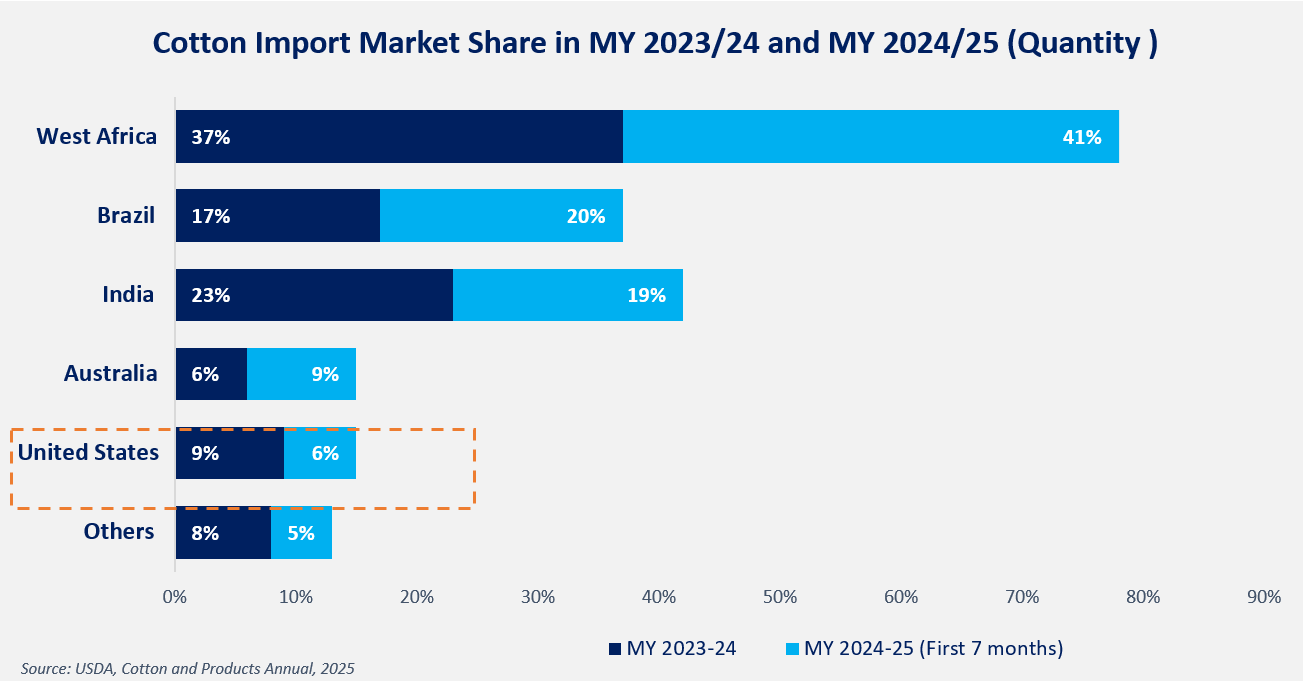GET IN TOUCH
- Please wait...

Amid shifting global dynamics, the U.S. tariff policy, initially a major concern for Bangladesh’s export sector, has settled at an additional 20 percent, offering some relief.i This matters deeply, as the U.S. remains one of Bangladesh’s largest export destinations (In 2024, Bangladesh held 9.3 percent of the $85 billion US apparel market).ii
While the country stays competitive with peers like Vietnam and fares better than India, broader geopolitical and economic uncertainties still loom.

Table 1: Tariff Rates Comparison with Major Competitorsiii
These changes in U.S. tariffs, especially toward major Asian exporters, are reshuffling sourcing decisions for global brands. Amid this reconfiguration, Bangladesh finds itself navigating both renewed opportunity and increased exposure. Maintaining market share and seizing potential gains will require speed, strategic positioning, and a clear understanding of emerging risks.
Amidst this uncertainty, Bangladesh’s position is both promising and precarious. Now the world’s second-largest garment exporter, with a 7.4% global shareiv, stands at the center of a shifting global apparel landscape. The recent U.S. move to raise tariffs on Chinese products to 50-55% and 60% on Indian products creates significant competitive advantage for Bangladesh.
Shifting orders from China due to price differential will likely benefit Bangladesh. While Vietnam captures the higher value-added segment, Bangladesh remains competitive in low-cost, volume-driven categories. Encouraged by the U.S. government’s push to diversify sourcing away from China, Bangladesh has already begun to benefit.v

Figure 1: Bangladesh’s Export to U.S.A
Exports from Bangladesh to the U.S. have reflected a positive trend in recent months. This shift highlights Bangladesh’s growing appeal as a sourcing destination amidst the changing trade landscape. In the first half of 2025, apparel exports to the U.S. surged by over 25%, outpacing global and regional competitors.vi The numbers indicate not just higher demand but also a growing integration into U.S. supply chains.
As tariffs and inflation climb, consumers, especially in lower- and middle-income brackets, are likely to cut back on discretionary spending, including apparel. This could pose a challenge for Bangladesh, whose apparel exports cater largely to price-sensitive segments of the U.S. market. Even a modest contraction in overall demand could offset the benefits of order diversion from China. Ultimately, Bangladesh’s export performance will hinge on whether a possible decline in consumer demand will likely offset by a shift in orders from competing countries.
Despite tariff uncertainty in the last few months, Bangladesh continued to experience export growth from the U.S. in July 2025., RMG exports totaled approximately U.S.$820 Mn.vii U.S. inflation rose 2.7% year-over-year in June 2025.viii There is also a rising cost across clothing lines that reflects a visible impact of tariffs on retail pricing. Persistent inflation tends to favor cost-competitive suppliers, such as those in Bangladesh. Yet, elevated inflation also reduces consumer discretionary spending, tightening overall apparel demand.
This also creates a possibility of stagflation if this inflation and interest rateix continues to stay at an elevated level. Tariff-induced price hikes, particularly on imported goods like apparel, will strain middle-income households. If this trend persists, it could dampen demand for price-sensitive categories where Bangladesh thrives, causing a risk to the country’s recent export momentum.
As global firms recalibrate their sourcing strategies due to the shifting trade winds, Bangladesh is emerging as a strong “China plus U.S. one” contender, offering cost efficiency, large-scale capacity, and improved infrastructure. With average monthly wages around U.S.$110x and a track record of enhanced compliance post-Rana Plaza, the country is attracting not only Western brands but also major Chinese investors like Handa Industries and China Power International Limited, spurred by BIDA’s recent outreach.xi
The newly imposed additional 50% U.S. tariff on Indian apparel has further boosted Bangladesh’s appeal as a sourcing destination. Duty-free access to the EU and a rising pipeline of foreign investments are positioning Bangladesh not as a backup, but as a strategic link in the future global supply chain. Still, without addressing structural inefficiencies like logistics bottlenecks and governance issues, this momentum may prove short-lived.
Despite growing interest from foreign investors, Bangladesh continues to face challenges in attracting long-term foreign direct investment. In the World Bank’s latest B-Ready assessment, the country ranked 29th among 50 countries, with particularly weak performance in public service delivery (score ~41.5).xii
Trade logistics remains another sore spot, Bangladesh ranks 88th globally on the World Bank Logistics Performance Index.xiii Operational inefficiency and bureaucratic delays have been affecting investor confidence for a long time and without urgent intervention, we will fail to capitalize on this opportunity of becoming a global sourcing hub.
However, unlocking full benefits from the U.S. tariff concessions will require structural changes, especially in value addition. As part of the negotiation with US, at least 40% of a garment’s value must be added locally for it to qualify as “Made in Bangladesh.”xiv This condition was mostly set to curb the overreliance on Chinese raw materials by Bangladeshi RMG exporters.
This condition poses a structural challenge within Bangladesh’s export ecosystem. While the knitwear segment stands strong with local spinners meeting nearly 90% of its fabric demand, the story is quite different for woven garments, particularly shirts and trousers bound for the American market.

Figure 2 : Woven Garments’ Raw Materials Composition for Bangladeshxv
Here, maximum woven fabric continues to be sourced from China, making the sector far more vulnerable to external supply shocks.
Another important matter to consider is under the revised U.S. tariff framework, if U.S.-origin inputs account for at least 20% of a product’s customs value, only the non-U.S. portion is subject to additional duties. This creates a potential advantage for Bangladeshi exporters using U.S. cotton or textile inputs, allowing them to reduce their effective tariff burden. However, realizing this benefit requires strict documentation and traceability of U.S. components.
Bangladesh currently sources only 6–9% of its cotton from the U.S., well below the required threshold. Logistical challenges further complicate matters, as U.S. cotton shipments can take over 30 days to arrive, compared to just 2–3 days from India at often lower prices.

Figure 3: Cotton Import Market Share
Note: MY is the cotton marketing year for the USDA, and most of the world begins on August 1st and ends on July 31st of the following year.
To truly leverage the potential shift of U.S. orders away from China and India, Bangladesh must invest in strengthening its backward linkage, especially for high-value woven garments like blazers, sweaters, and MMF-based apparel, which still rely heavily on imported raw materials. With a fiber mix of 28%, largely imported, compared to India’s 30% with stronger domestic integration,xvi developing a recycled MMF industry and adopting modern technologies is essential.
At the same time, improving ease of doing business and reducing logistical inefficiencies will be key to attracting investment and enabling the country to deliver both basic and high- performance apparel. Only through strategic reforms and value-added capabilities can Bangladesh truly position itself to absorb shifting U.S. orders and retain its competitive edge.
I. The White House. (2025, July 31). Further Modifying the Reciprocal Tariff Rates (Executive Order). Retrieved August 8, 2025, from https://www.whitehouse.gov/presidential-actions/2025/07/further-modifying-the-reciprocal-tariff-rates/
Ii. Mirdha, R. U. (2025, August 9). Tariff math favours Bangladesh in shifting US trade landscape. The Daily Star. Retrieved August 9, 2025, from The Daily Star website.
Iii. The White House. (2025, July 31). Further modifying the reciprocal tariff rates [Presidential action]. https://www.whitehouse.gov/presidential-actions/2025/07/further-modifying-the-reciprocal-tariff-rates/
Iv. Bangladesh retains the 2nd largest RMG exporter ranking
Dhaka Tribune. (2025, August 5). Bangladesh retains the 2nd largest RMG exporter ranking. Dhaka Tribune. https://www.dhakatribune.com/bU.S.iness/353670/bangladesh-retains-2nd-largest-rmg-exporter
v. Staff Correspondent. (2025, August 6). RMG exports to US see 25 pc growth in Jan–Jun. New Age. Retrieved August 8, 2025, from https://www.newagebd.net/post/apparel/272287/rmg-exports-to-us-see-25pc-growth-in-jan-jun
vi. Staff Correspondent. (2025, August 6). RMG exports to US see 25 pc growth in Jan–Jun. New Age. Retrieved August 8, 2025, from https://www.newagebd.net/post/apparel/272287/rmg-exports-to-us-see-25pc-growth-in-jan-jun
vii. Bangladesh Sangbad Sangstha (BSS). (2025, August 8). US 20% counter-tariff kicks in, triggers export surge at Ctg Port. BSS. Retrieved August 9, 2025, from BSS Business section.
viii. U.S. Bureau of Labor Statistics. (2025, July 23). The Consumer Price Index rose 2.7 percent for the 12 months ending June 2025. https://www.bls.gov/opub/ted/2025/consumer-price-index-rose-2-7-percent-for-the-12-months-ending-june-2025.htm
Ix. Acharya, B. (2025, July 9). Trump says U.S. interest rate is at least 3 points too high. Reuters.
x. Webb, B. (2024, January 11). “A heightened atmosphere of fear”: Bangladeshi garment workers’ fight for fair pay isn’t over. Vogue Business.
xi. Star Business Report. (2025, July 27). Chinese businesses keen to invest in Bangladesh: Ashik Chowdhury. The Daily Star. Retrieved August 8, 2025, from https://www.thedailystar.net/business/news/chinese-businesses-keen-invest-bangladesh-ashik-chowdhury-3949156
xii. The Business Standard. (2024, August 6). Bangladesh ranks 29 in World Bank’s B-Ready index. The Business Standard. https://www.tbsnews.net/economy/bangladesh-ranks-29-world-banks-b-ready-index-909331
xiii. Bangladesh Textile Journal. (2023, April 30). Bangladesh up by 12 notches in World Bank’s Logistics Performance Index 2023. Bangladesh Textile Journal. https://bangladeshtextilejournal.com/bangladesh-up-by-12-notches-in-world-banks-logistics-performance-index-2023/
xiv. Mirdha, R. U. (2025, July 10). US–China tariff war punishes Bangladesh. Asia News Network. Retrieved August 8, 2025, from https://asianews.network/us-china-tariff-war-punishes-bangladesh/
xv. Mirdha, R. U. (2025, July 10). US–China tariff war punishes Bangladesh. Asia News Network. Retrieved August 8, 2025, from https://asianews.network/us-china-tariff-war-punishes-bangladesh/
Shoumik Shahriar, Project Manager and Senior Business Consultant, Sadia Karim, and Sakina Binte Belayet, Business Analysts, at LightCastle Partners have co-authored the article. For more information, please reach out: [email protected]
Our experts can help you solve your unique challenges
Stay up-to-date with our Thought Leadership and Insights